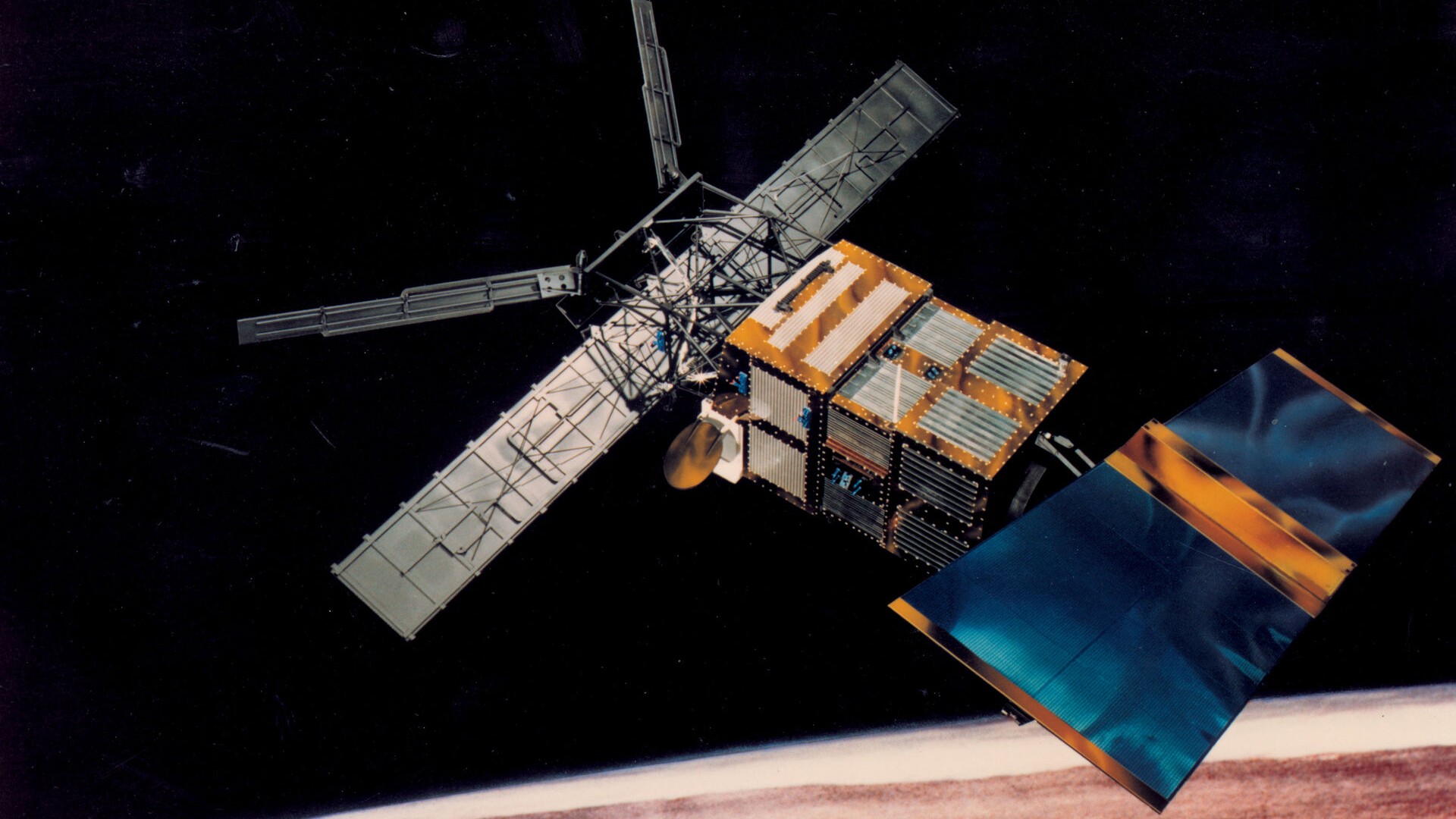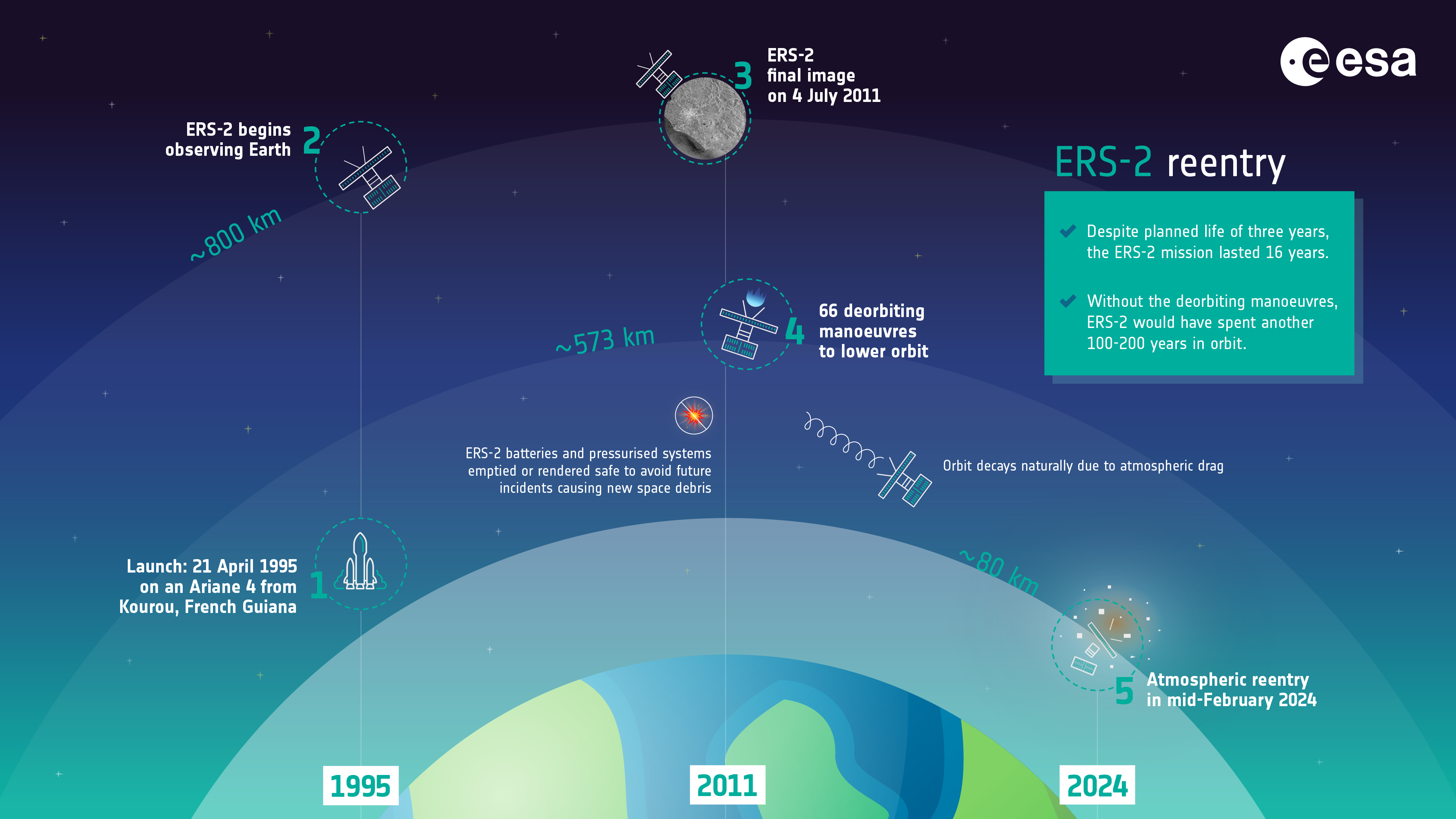Big, dead satellite's crash was a space-junk wakeup call, experts say

"We shouldn't be relying on luck to mitigate casualty risks."

There is some interesting residual fallout from the recent nosedive to Earth of the European Remote Sensing satellite, or ERS-2.
Following its launch in April 1995, ERS-2 studied our planet for nearly 16 years. Then, in 2011, the European Space Agency (ESA) decided to bring the radar-toting spacecraft's mission to an end. The agency commanded a series of deorbit maneuvers, which lowered the satellite's average altitude and mitigated the risk of collision with other satellites or space debris.
The spacecraft was also "passivated" to reduce the risk of fragmentation. Passivation involves getting rid of internally stored energy, like venting unused propellant and de-charging batteries (which, if left charged, could cause a detonation).
"No intervention can be made from the ground, so ERS-2 will return entirely naturally — now a common occurrence as on average one spacecraft reenters Earth's atmosphere per month," an ESA pre-fall statement explained. The term "return entirely naturally," however, is arguably a user-friendly substitute for "uncontrolled."
Related: The biggest spacecraft to fall uncontrolled from space
Following the fall
ESA's Space Debris Office predicted that the reentry of ERS-2 would take place on Feb. 21 at 10:41 a.m. EST (1541 GMT). In reality, the craft made its plunge some two hours later, reentering the atmosphere over the North Pacific Ocean.
The European Space Operations Center (ESOC), home for engineering teams that control spacecraft in orbit, did note that the earlier prediction came with a plus or minus value of 1.44 hours.
Breaking space news, the latest updates on rocket launches, skywatching events and more!
Still, in the uncontrolled space debris business, minutes — indeed, even seconds — count. They can be the difference between a hunk of space junk falling into isolated ocean waters or crashing down within a populated area.
In fact, it's likely that parts of the 2.5-ton ERS-2 did survive the fiery reentry. On average, between 10% and 20% of larger objects' mass makes it through the atmosphere and hits the ground or water, said Simona-Elena Nichiteanu, an ESOC media relations officer.
Before the fall of ERS-2, Nichiteanu told Space.com that the biggest and heaviest scraps that might survive relatively intact are four spacecraft tanks, a trio of internal panels supporting spacecraft instruments and the antenna structure for the satellite's Synthetic Aperture Radar antenna, potentially the largest piece, assuming that it did not break apart.
But we'll likely never know how much of the bus-sized ERS-2 survived, given the reentry locale.
"No damage to property has been reported," an ESA statement explained following the fall of ERS-2.
Related: Big, doomed satellite seen from space as it tumbled toward a fiery reentry on Feb. 21 (photos)
Willy-nilly satellite falls
But the willy-nilly nature of an out-of-control satellite fall is cause for the willies.
That's the view of Ewan Wright, a Ph.D. candidate at the University of British Columbia and junior fellow of the Outer Space Institute. He is actively focused on the sustainability of the outer space environment.
In the future, Wright told Space.com, all large satellites should do controlled reentries.
"Operators should control them to reenter over the oceans, away from people, aircraft and ships," said Wright. "ERS-2 reentered in the North Pacific. If it had reentered half an hour earlier, it could have hit Europe or Africa," he said.
And the North Pacific sees air traffic traveling between Asia and North America, and to Hawaii, Wright pointed out.
"Luckily, aircraft weren't impacted this time," he said. "Even if aircraft aren't hit by space debris, the uncertainty can cause airspace closures and route diversions, costing airlines and passengers money."
There's ship traffic to worry about, too — and not just in the final reentry zone, given how fast orbiting objects move. Pieces of broken-apart satellites can conceivably come down over a wide stretch of the objects' reentry trajectory.
Indeed, there was a reported ERS-2 debris-related warning to a Princess Cruises ship carrying 2,200 passengers, according to cruiseradio.net. The ship, Island Princess, was notified by a coordinated message from ESA and the National Hydrographic Office that ERS-2 odds and ends might fall into the area the pleasure boat was set to cross, en route to Port Luis, Mauritius. The Island Princess steered clear of the area, taking a different course.
For Wright, the bottom line is this: "We shouldn't be relying on luck to mitigate casualty risks. Instead of rolling the dice, operators should use controlled reentries, directing satellites to reenter away from people and aircraft."
Global standard
Darren McKnight is a senior technical fellow for LeoLabs, a commercial provider of space domain awareness services and low Earth orbit mapping based in Menlo Park, California.
McKnight said that the probability of casualties on the ground from a single reentry is small. However, the aggregate risk grows over time.
"It is not a question of 'if' but rather 'when' a derelict object will survive to Earth's surface and result in significant damage, a fatality or injury," McKnight told Space.com.
And when that fateful day arrives, there will be an uproar regarding uncontrolled satellite reentries, McKnight said. The "global standard" is the 25-year rule — that is, get each satellite out of orbit within 25 years of the end of its mission, he added.
"But the U.S. is the only one that requires operators to minimize the casualty risk to people on the ground from reentry," said McKnight. "This will evolve just as the 25-year rule is evolving to a five-year rule, one that is only required by the Federal Communications Commission at this point."
Old rules
On the other hand, we will have decades of reentries based upon the old rules, McKnight said. Further, most of the derelict mass in orbit right now, he said, consists of objects that launched in the 1980s and 1990s, when there were no mitigation rules at all.
The slower that regulations evolve, the more complicated it will be to determine their benefits, since there is a mix of hardware in orbit, McKnight said.
"I also think that it is interesting that, as regulation has been leaning to push operators to design the spacecraft for demise and insure they disintegrate upon reentry, some folks are now getting concerned about the contamination of the atmosphere from space launch effluents and disintegrating spacecraft reentering," McKnight noted.
That situation is getting more and more complicated as the amount of material grows and grows, according to McKnight. "Nobody is going to be happy!" he said.
Hot topic
Dead-satellite falls like that of ERS-2 happen quite regularly, said Leonard Schulz, a researcher at the Technische Universität Braunschweig's Institute of Geophysics and Extraterrestrial Physics in Germany.
Such reentries will only increase in the future, Schulz told Space.com, due to the growing number of objects brought into low Earth orbit. Furthermore, there's a need to consider the effects on the atmosphere from spacecraft reentry, a hot topic that ESA is also evaluating.
"Today, we are lacking information on many aspects when it comes to materials released and subsequent effects on the atmosphere," said Schulz.
Satellite reentries are a good opportunity to gather data with measurement campaigns, Schulz advised. However, uncontrolled reentries like that of ERS-2 are extremely difficult to observe, he said, as the uncertainty level of where the satellite actually reenters is so high.
"But controlled reentries provide great measurement opportunities," Schulz concluded, "which should be a focus in the future!"

Leonard David is an award-winning space journalist who has been reporting on space activities for more than 50 years. Currently writing as Space.com's Space Insider Columnist among his other projects, Leonard has authored numerous books on space exploration, Mars missions and more, with his latest being "Moon Rush: The New Space Race" published in 2019 by National Geographic. He also wrote "Mars: Our Future on the Red Planet" released in 2016 by National Geographic. Leonard has served as a correspondent for SpaceNews, Scientific American and Aerospace America for the AIAA. He has received many awards, including the first Ordway Award for Sustained Excellence in Spaceflight History in 2015 at the AAS Wernher von Braun Memorial Symposium. You can find out Leonard's latest project at his website and on Twitter.


